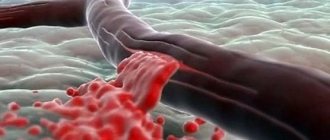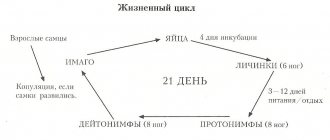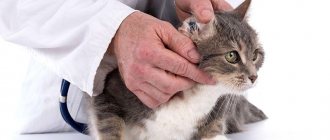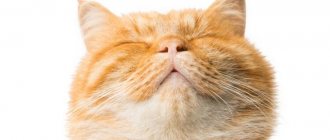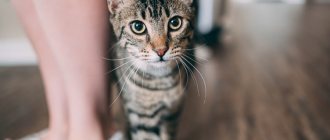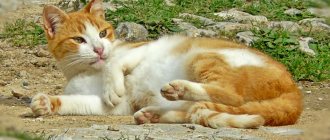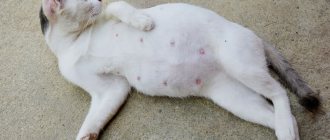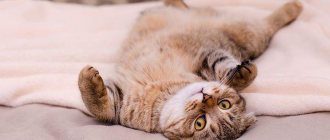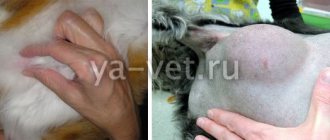A hernia in a cat is one of the most common pathologies requiring surgical intervention. In veterinary medicine, this disease is usually understood as anatomically weakened places in the muscular layer of the pet’s body, into which internal organs can get trapped and pinched. The presence of a hernia causes a lot of trouble for your pet, and in some cases it can provoke purulent abscesses and even death. The article will discuss in detail the types of hernias, the causes of their appearance and symptoms, and will also answer the question of what the owner should do if they are detected in a cat.
Types of pathology
Experts divide hernias in cats into those that were received at birth and those that were “earned” during life. In the first case, they arise due to various disorders in the development of the fetus while it was still in the womb. The second option occurs due to abnormal physical activity that exceeds the pet’s capabilities or serious injuries.
Another classification of the disease involves distinguishing hernias by their location on the body of mustachioed pets. These include:
- Diaphragmatic type. It occurs due to the displacement of the cat’s internal organs from the abdominal cavity into the chest. This is done through such vulnerable and delicate parts of the diaphragm as the areas of attachment to the sternum, or through the esophageal opening. Statistics have shown that in most cases, patients with a mustache end up on the operating table with this diagnosis due to injuries.
- Intervertebral type. It is caused by the fact that the intervertebral disc of the animal is displaced into the canal of the vertebrae itself, where it is pinched. A kitten is practically not at risk of such a hernia; it affects only those individuals that have reached the age of more than 14-15 years.
- Pericardial-peritoneal. They are very rare in veterinary practice. They are expressed in the fact that organs entering the chest from the abdominal cavity intensely compress the heart, provoking its dysfunction. The mortality rate from this disease is extremely high, as it is aggravated by pulmonary edema and acute heart failure.
- Umbilical hernia in cats is more often congenital than acquired. The pathology is characterized by the release of adipose tissue, mesentery or intestinal loop into the fibrous ring with subsequent pinching.
- Crotch type. Its main location is between the cat's uterus. In this case, the pet often loses part of the bladder, peritoneum or the uterus itself. They do not get pinched and adjust well.
- An inguinal hernia is located in a cat in the place where the spermatic canal enters the scrotum (in males), and in females - into the inguinal canal. It is typical that in females it is provoked by problems of the gastrointestinal tract such as constipation and flatulence.
Read also:
How to relieve a cat's pain? What medications are dangerous for cats?
Urological syndrome in cats: what to do if your cat has problems with urination?
Kidney failure in cats: symptoms and treatment
Contributor Bio
Dr. Sarah Wooten
Dr. Sarah Wooten graduated from the UC Davis School of Veterinary Medicine in 2002. A member of the American Society of Veterinary Journalists, Dr. Wooten divides his professional time between his private small animal practice in Greeley, Colorado, public speaking on peer issues, leadership and client communication, and writing. She enjoys being outdoors with her family, skiing, scuba diving and participating in triathlons.
Symptoms of the disease
The symptoms of the pathology depend entirely on the location of the hernia and those organs that were pinched. In view of this, we will consider each variety in more detail.
Diaphragmatic hernia
The animal becomes apathetic and inactive. Over time, breathing problems appear - shortness of breath or attacks of suffocation. Regular oxygen deprivation of the body causes the mucous membranes of the cat to turn blue. In particularly difficult cases, pulmonary edema is very likely, provoked by the pressure of the abdominal organs on the large vessels of the pet’s body.
Umbilical hernia
In the abdominal area, protrusion of tissue is clearly visible. It is soft to the touch and does not cause painful reactions in the cat upon palpation. If pinching does not occur, then the pathology when pressed is well “put into place” when you press on it. Otherwise, signs such as increased body temperature, pain during palpation, and severe vomiting are possible. If medical care is not provided in time, a umbilical hernia can cause sepsis and death of adjacent tissues. This type of disease is typical of kittens, especially those 3 weeks old, whose umbilical cord was cut too close to the belly.
Inguinal type
Outwardly it resembles a small soft ball at the bottom of the abdomen. Abdominal hernia is quite common in female cats. A painless form of the disease, the animal may not react to it in any way. However, in the long term, such a hernia can lead to prolapse of the pet’s bladder or uterus. As a result, complete infertility or bladder rupture is possible, followed by a state of shock.
Crotch type
Does not cause concern to the cat, even with intense palpation. It does not get pinched and is pressed well into the body. Moreover, if you take the pet by the front paws and lift it up, the hernia will increase in size, and if by the hind paws, then, on the contrary, it will decrease.
Intervertebral hernia
The disease is localized in the lumbar vertebrae of the cat. The normal activity of the cat’s musculoskeletal system is disrupted, as a result it begins to move stiffly, its gait becomes unsteady, and it is difficult for it to jump and climb stairs. Over time, this leads to atrophy of the leg muscles and partial paralysis. If the pinched spinal cord succumbs to serious degenerative changes, then complete paralysis is very likely. Moreover, nothing can be done about this, since the damage concerns the tissues of the spinal cord, which lie too far and make any intervention hopeless.
Additional signs of any of the hernias (if pinched) may include symptoms such as vomiting or diarrhea, the bulging tissue is hot to the touch, and the cat intensively licks the affected area. The owner should carefully monitor such signs and, if they appear, immediately take the pet for examination to a doctor.
Why is a hernia dangerous?
Any hernia is dangerous for the development of complications. The most serious complication of a hernia is strangulation. It occurs when the blood supply to the contents of the hernial sac is disrupted and tissue necrosis occurs.
An equally serious complication is intestinal obstruction. As a result of the prolonged presence of intestinal loops inside the hernial sac, they are compressed, the movement of intestinal contents through them is disrupted, and intestinal obstruction forms.
It is very important to understand that the development of complications can occur suddenly, against the background of complete well-being: on vacation, at the dacha, while traveling - in situations where qualified medical care is difficult to access or not available at all. Treatment of hernia complications requires emergency intervention, and delay can lead to a sharp deterioration in a person’s condition and significantly worsen the prognosis of delayed treatment.
Therefore, it is better to get rid of the hernia before complications develop.
Diagnosis of the disease
The diagnosis of external protrusion is based on the clinical symptoms of the disease, as well as with the help of palpation, thanks to which the specialist is able to determine the presence or absence of pinching. If a cat is suspected of having an internal form of pathology (intervertebral or diaphragmatic varieties), then additional diagnostic procedures will be required, including ultrasound, x-ray, myelography and MRI.
A diaphragmatic hernia can be detected by x-ray. The accuracy of the diagnosis will be increased by barium contrast; it is introduced into the pet’s body by feeding it food to which powder has been added. This will allow you to determine the location of the intestinal loops. It is also permissible to conduct electrocardiography to monitor the normal functioning of the cat's heart.
What to do: what treatment is provided
There is no drug treatment for diaphragmatic hernia; drugs are prescribed as auxiliary ones, but the main therapy is only surgical. Moreover, the faster the cat owner delivers the pet to the clinic, the higher the chance of a successful outcome.
The surgical operation consists of suturing the hernial opening in the diaphragm. If stabilization of the animal before the intervention is impossible, then an emergency operation is performed using a ventilator and the cat’s further stay in the intensive care unit and hospital of the veterinary clinic.
If your cat has suffered serious injuries (road accident, bruises from a fall, fractures, etc.), it is necessary to urgently deliver it to the RosVet EC. You can inform about your arrival by phone: + 7 (495) 256-11-11. Also, with a congenital pathology, the owner may notice signs of breathing problems, which will also be a reason to come to the clinic or call a doctor at home.
Medical therapy
Treatment is divided into two types: conservative and surgical. The first option is ideal for cases where the hernia protrudes slightly and there is no pinching at all. Most often, the inguinal forms of the disease are eliminated without surgical intervention. For this method of treatment, the cat is put on a tightening blanket, which he will be required to wear for a couple of months in a row, and the bulge itself is first adjusted by a doctor. In this case, the abdominal defect can heal on its own.
If, after diagnosis, the veterinarian determines that conservative treatment will not give a positive result, then removal of the hernia will be required. Moreover, without pinching, the operation is carried out according to the following scheme: the protruding organ is reduced and the wound is sutured. And with pinching this way: the hernia sac is excised absolutely completely, along with those internal organs that were pinched in it.
Diaphragmatic and intervertebral hernias deserve special attention. In the first case, the animal’s chest is opened by a surgeon, and the organs “retracted” into it are set back into the abdominal cavity. Then the diaphragm is sutured, but before that the doctor performs plastic surgery by placing a special mesh on this part of the cat’s body or using adjacent tissue. If organs are infringed, then be prepared for the fact that their resection will be required. It is important for owners to understand that the cat will need careful post-operative monitoring. This will help prevent the lungs from collapsing or blood circulation in the sternum being disrupted.
In the case of intervertebral hernias, medication therapy is possible in the early stages. Both steroidal (Prednisolone) and non-steroidal (Rimadyl) drugs have proven effective. Please note that you will need to observe restrictions on the movement of your mustachioed pet for 1-2 months. If the disease was discovered late, then the prolapsed disc and part of the vertebra at the site of the pathology are removed surgically. After the operation, the pet will be exhausted, so he will be prescribed courses of vitamins and complete rest. Unfortunately, this hernia in the later stages is incurable. In order not to torment the cat, the doctor will recommend euthanasia.
List of used literature
- Chikinev Yu.V., Drobyazgin E.A. POST-TRAUMATIC DIAPHRAGMAL HERNIA (DIAGNOSTICS AND TREATMENT). Acta Biomedica Scientifica. 2017;2(6):163-166.
- Voitsekhovsky V.V., Anikin S.V., Goborov N.D., Yanovoy V.V., Bregadze Yu.E., Glushchenko V.V., Khatkeev V.I. A case of diagnosis of post-traumatic diaphragmatic hernia occurring under a mask pleurisy. Bulletin of physiology and pathology of respiration. 2017;
- Grishin, I. N. Hiatal hernia and reflux gastroesophageal disease: monograph. / I.N. Grishin, A.V. Vorobey, N.N. Chur. - M.: Higher School, 2015. - 224 p.
- Long-term results of endosurgical treatment of paraesophaneal hiatal hernias, E. I. Senderovich, E. E. Grishina, B. M. Garifullin, E. F. Gimaev, N. M. Kazakov, R. K. Ibragimov
Prevention of the disease
Preventive measures to prevent a hernia from occurring in a meowing pet are quite simple to implement. These include:
- Quick response to problems that arise regarding the process of digestion and bowel movements.
- Breeders of purebred cats should limit the number of matings and births of their pets.
- Owners living on the upper floors are not recommended to allow the animal to sleep on the windowsill or move freely along the ledge. Try not to open windows and balconies unnecessarily; although cats are dexterous representatives of the fauna, they often do not calculate their strength and fall down.
- Monitor your cat’s diet, enrich it with vitamins and microelements.
- Avoid excessively intense physical activity for your pet.
A hernia is a serious disease that can disable and kill an animal if the owner is inattentive to the health of his animal. A number of the above recommendations, as well as scheduled examinations with a veterinarian at least once a month, will help you avoid pathology.
